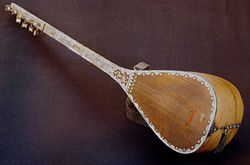Ашуг


Ашу́г (ашык) (азерб.: Aşıq, арм.: Աշուղ, перс.: عاشیق)[1] — народны спявак-паэт у азербайджанцаў[1][2][3][4] і армян[3][4][5], а таксама іншых народаў Закаўказзя[6]. З'яўляецца эквівалентам менестрэля ў англійскай і трубадура ў французскай сярэднявечнай традыцыі[7]. У азербайджанскай музычнай традыцыі ашуг акампануе сабе на сазе[3], граючы таксама пад музыку балабана і дафа[8]; у армянскай — на тары, кеманчы[3], сантуры, кануне, сазе[9] і кемані[10].
Гл. таксама
[правіць | правіць зыходнік]Зноскі
- ↑ а б Вялікая савецкая энцыклапедыя. Артыкул: Ашуг Архівавана 29 лістапада 2014.
- ↑ Encyclopædia Iranica. Артыкул: ʿĀŠEQ (Asheq)
- ↑ а б в г Э. Абасова. Ашуг // Музыкальная энциклопедия / Ю. В. Келдыш. — М.: Сов. энциклопедия"--"Сов. композитор", 1973—1982..
- ↑ а б А. А. Сурков. Ашуг // Краткая литературная энциклопедия. — 8. — М.: Сов. энциклопедия, 1962. — Т. 1. — С. 368.
- ↑ Armеniа, §I: Trаditiоnаl musiсs 4. The ‘gusanner’. // Nеw Grоvе Ditiсtiоnаrу оf Мusiс аnd Мusiсiаns / Stanley Sadie, John Tyrrell. — 2. — Oxford University Press, 2001. — 2500 с. — ISBN 0195170679, 9780195170672.
- ↑ Краткий музыкальный словарь(недаступная спасылка)
- ↑ Marc Nichanian // Mourning Philology: Art and Religion at the Margins of the Ottoman Empire // Fordham University Press.
- ↑ J. During. Music of Azerbaijan (англ.). — Encyclopædia Iranica. — 1988. — Т. III. — С. 255-257.
In the popular domain, the ʿāšeq bards have never stopped singing in cafes and at family celebrations, accompanying themselves on the sāz (čoḡūr in Azerbaijani Persian) and also accompanied by the reed flute (bālamān) and the tambourine (qawan[w]āl).
- ↑ Alina Pahlevanian. Armenia I. Folk music. 6. The ‘ashughner’ // Nеw Grоvе Ditiсtiоnаrу оf Мusiс аnd Мusiсiаns / Stanley Sadie, John Tyrrell. — 2. — Oxford University Press, 2001. — 2500 с. — ISBN 0195170679, 9780195170672.
- ↑ Ellen Koskoff. Armenian music. Ashugh // The Concise Garland Encyclopedia of World Music, Том 2. — Routledge, 2008. — Т. 2. — С. 1406. — ISBN 0415972930, 9780415972932.Арыгінальны тэкст (англ.)
Typically, an ashugh treated his profession -and his instrument - with deep respect. He would often create songs dedicated to his own role or to the instrument he was using. The instruments, primarily strings, varied; they included the k'amanch'a, k'eman, k'anon, s'az, far, and violin. As a rule, the last stanzas of a song would give the author's name or pseudonym. Many Armenian ashughner compiled manuscripts of their lyrics, although the melodies were transmitted as an oral tradition. The most prominent representatives of the tagher and ashugh art of this period are Naghash Hovnat'an (1661 – 1722) and Paghtasar Dpir (1683 - 1768); their lyrics have been published, and their melodies are still sung today.
Літаратура
[правіць | правіць зыходнік]- Г. Тарведян: «Армянские ашуги».
- Кочарян А., Армянская народная музыка, М.-Л., 1939
- Мсерианц Л. М., Ашуги, Литературная энциклопедия, Изд-во Ком. Акад., 1930.
- В. Кривоносов: «Ашуги Азербайджана», журнал «Советская музыка», 1938, № 4;
- А. Мирахмедов: Избранное, Баку, 1963, в сборнике: «Антология азербайджанской поэзии», том I.
